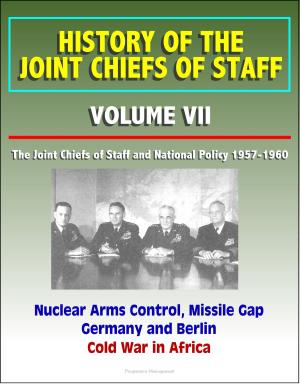Citizen Airmen: A History of the Air Force Reserve, 1946-1994 - Unit Activations, Pay Issues, Mobilization for Korea, Fear of Flying, Berlin Crisis, Cuban Missile Crisis, Vietnam, Air Refueling
Nonfiction, History, Military, Vietnam War, Asian, Aviation| Author: | Progressive Management | ISBN: | 9781311991232 |
| Publisher: | Progressive Management | Publication: | June 28, 2015 |
| Imprint: | Smashwords Edition | Language: | English |
| Author: | Progressive Management |
| ISBN: | 9781311991232 |
| Publisher: | Progressive Management |
| Publication: | June 28, 2015 |
| Imprint: | Smashwords Edition |
| Language: | English |
Professionally converted for accurate flowing-text e-book format reproduction, this unique USAF publication presents a thorough history of the Air Force Reserve. The book begins with the fledgling air reserve program initiated in 1916, traces its progress through World War II, and then concentrates on the period 1946 through 1994. The study skillfully describes the process by which a loosely organized program evolved into today's impressive force. The Air Force Reserve story is told within the context of national political and military policy and stresses that over the decades, as national needs have increased, reservists have met the challenges. Initially, the Air Force treated its reserve units as supplemental forces and equipped them with surplus equipment. Shortly after the Air Force Reserve was established in 1948, its members mobilized for Korean War duty and they served throughout the conflict. The Reserve program subsequently fell into disarray and required patient rebuilding. The passage of a series of key federal laws related to personnel issues and the introduction of the air reserve technician program greatly assisted in this rejuvenation process. In the 1960s, the Air Force Reserve demonstrated its mettle as it participated in numerous mobilizations reflecting the Cold War tensions of the era. Reservists were involved in operations ranging from the Berlin Crisis of 1961-1962 to the Southeast Asia mobilizations in 1968. In the 1970s, the Air Force Reserve program assumed heightened importance when the Department of Defense adopted the Total Force Policy. This concept treated the active forces, the National Guard, and all reserve forces as an integrated force. Reservists were now expected to meet the same readiness standards as their active duty counterparts. Since then, the Air Force Reserve has demonstrated its ability to perform a wide variety of missions. Air Reservists participated in American military operations in Grenada and Panama. During Desert Shield and Storm, some 23,500 reservists were mobilized for service. They performed in combat in the Persian Gulf and provided vital support services at overseas locations. Stateside, they served at home stations or other locations in place of deployed active duty personnel. Today, the Air Force Reserve performs major portions of the Air Force mission.
CHAPTER 1 - THE NATIONAL DEFENSE ACT TO PEARL HARBOR, 1916-1941 * Origins of the Air Reserve * The Air Reserve Between the Wars * CHAPTER 2 - THE FIRST POSTWAR AIR RESERVE PROGRAM, 1946-1947 * Administration and War Department Policies * Army Air Forces Reserve Policies and Plans * The Initial Air Reserve Management Structure * Early Problems in Conducting the Air Reserve Program * The Impact of Budget Reductions * The State of Reservists' Records * Major Command Cooperation with the Air Defense Command * Activation of Units * The Formation of Composite Units * Training Mobilization Assignees * Active Duty Training for Air Reservists * The Air Reserve's Disgruntled Publics * The Role of the Associations * Evaluating the First Effort * CHAPTER 3 - DEVELOPMENT OF A NEW PROGRAM, 1948-1949 * The Selective Service Act of 1948 and the Reserve * The Gray Committee Reviews the Civilian Components * Development of U.S. Air Force Reserve Policies * The President Demands a Revitalization of the Reserve Program * Phasing the 1950 Program into Being * Miscellaneous Lasting Developments of the First Program * Resolution of the Inactive Duty Training Pay Issue * Provision of Retirement Benefits for Reservists * Provision for Blacks and Women in the Air Reserve * The Air Reserve and Service Unification * General Whitehead Evaluates the Program * CHAPTER 4 - MOBILIZATION FOR KOREA AND EXPANSION * Background of the Korean Mobilization * The 1950 Unit Mobilizations * Mobilization of the 375th and 433d Troop Carrier Wings
Professionally converted for accurate flowing-text e-book format reproduction, this unique USAF publication presents a thorough history of the Air Force Reserve. The book begins with the fledgling air reserve program initiated in 1916, traces its progress through World War II, and then concentrates on the period 1946 through 1994. The study skillfully describes the process by which a loosely organized program evolved into today's impressive force. The Air Force Reserve story is told within the context of national political and military policy and stresses that over the decades, as national needs have increased, reservists have met the challenges. Initially, the Air Force treated its reserve units as supplemental forces and equipped them with surplus equipment. Shortly after the Air Force Reserve was established in 1948, its members mobilized for Korean War duty and they served throughout the conflict. The Reserve program subsequently fell into disarray and required patient rebuilding. The passage of a series of key federal laws related to personnel issues and the introduction of the air reserve technician program greatly assisted in this rejuvenation process. In the 1960s, the Air Force Reserve demonstrated its mettle as it participated in numerous mobilizations reflecting the Cold War tensions of the era. Reservists were involved in operations ranging from the Berlin Crisis of 1961-1962 to the Southeast Asia mobilizations in 1968. In the 1970s, the Air Force Reserve program assumed heightened importance when the Department of Defense adopted the Total Force Policy. This concept treated the active forces, the National Guard, and all reserve forces as an integrated force. Reservists were now expected to meet the same readiness standards as their active duty counterparts. Since then, the Air Force Reserve has demonstrated its ability to perform a wide variety of missions. Air Reservists participated in American military operations in Grenada and Panama. During Desert Shield and Storm, some 23,500 reservists were mobilized for service. They performed in combat in the Persian Gulf and provided vital support services at overseas locations. Stateside, they served at home stations or other locations in place of deployed active duty personnel. Today, the Air Force Reserve performs major portions of the Air Force mission.
CHAPTER 1 - THE NATIONAL DEFENSE ACT TO PEARL HARBOR, 1916-1941 * Origins of the Air Reserve * The Air Reserve Between the Wars * CHAPTER 2 - THE FIRST POSTWAR AIR RESERVE PROGRAM, 1946-1947 * Administration and War Department Policies * Army Air Forces Reserve Policies and Plans * The Initial Air Reserve Management Structure * Early Problems in Conducting the Air Reserve Program * The Impact of Budget Reductions * The State of Reservists' Records * Major Command Cooperation with the Air Defense Command * Activation of Units * The Formation of Composite Units * Training Mobilization Assignees * Active Duty Training for Air Reservists * The Air Reserve's Disgruntled Publics * The Role of the Associations * Evaluating the First Effort * CHAPTER 3 - DEVELOPMENT OF A NEW PROGRAM, 1948-1949 * The Selective Service Act of 1948 and the Reserve * The Gray Committee Reviews the Civilian Components * Development of U.S. Air Force Reserve Policies * The President Demands a Revitalization of the Reserve Program * Phasing the 1950 Program into Being * Miscellaneous Lasting Developments of the First Program * Resolution of the Inactive Duty Training Pay Issue * Provision of Retirement Benefits for Reservists * Provision for Blacks and Women in the Air Reserve * The Air Reserve and Service Unification * General Whitehead Evaluates the Program * CHAPTER 4 - MOBILIZATION FOR KOREA AND EXPANSION * Background of the Korean Mobilization * The 1950 Unit Mobilizations * Mobilization of the 375th and 433d Troop Carrier Wings















